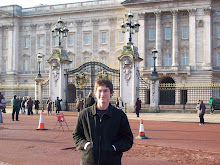
This is quite possibly the coolest thing I've ever seen. The bones from anywhere of 40,000 to 70,000 human skeletons were arranged into various works of art by František Rin, a Czech woodcarver and carpenter from the town of Ceska Skalice. He was commissioned by the House of Schwarzenberg to organize the bones exhumed from the Hřbitovní kostel Všech Svatých (Cemetery Church of All Saints) during the construction of the church. The bones belonged mostly to victims of the Black Death and the Hussite Wars. For reasons unknown, Rin commerated these victims and his sponsors with monstrances, giant goblets, a chandelier and the Schwarzenberg coat of arms. It was strangely peaceful in the chapel, not spooky or depressing, and I feel like what was crafted was done in a tone of reverence. This was one of the clinching factors in my decision to come to the Czech Republic and the satisfaction I felt upon exiting the chapel was immense.


From there, we saw the Church of St. Barbara which was under restoration. It was started in 1388 but because of dwindling revenue from the nearby silver mines combined with conflicting political factors, the Church was not completed until 1905. St. Barbara was the patron saint of miners and in a town like Kutna Hora, whose existence depended on the nearby silver mines, she was often and readily invoked. It is awe-inspiring to think that with only a few tools, building materials, and a creative drive fueled by spirituality that medieval people were able to construct these magnificent structures. Off in the distance, the Church of St. James' tower loomed against an overcast sky.

We stopped for lunch in a local diner and I had a modest meal of garlic soup (česneky polévka), potato pancakes (bramborák) and apple strudel (jablečný závin) with vanilla ice cream (Vanilková zmrzlina). Z ate with me and during the course of the meal we discussed places he had been and places I wanted to go. When he asked me why I came to the Czech Republic, I told him it was because I had never traveled abroad, that I had never met any Czechs and wanted to, that Praha had survived WWII almost unscathed, was in pristine condition and therefore of supreme interest to a History major, and that I wanted to challenge myself by studying in a foreign place with a strange language and rich culture. He thanked me for doing so, saying that he appreciated someone showing in an interest in his homeland, which was the most unexpected (and one the biggest) compliment(s) I've ever received.
After lunch, we toured the town square and surrounding streets. My camera's batteries died at this point but since I had managed to take a few photos (and since I had well-documented the ossuary) I wasn't too bummed. After roughly an hour, we piled back into the van and headed home. So ended one of my favorite excursions into the Czech countryside.









No comments:
Post a Comment